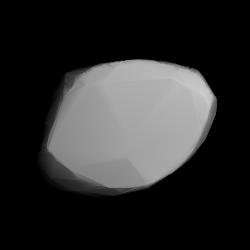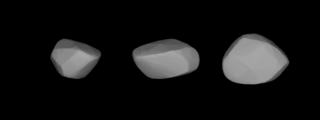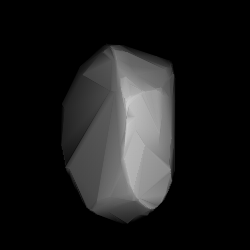Related Research Articles

1743 Schmidt, provisional designation 4109 P-L, is a dark background asteroid from the inner regions of the asteroid belt, approximately 19 kilometers in diameter. It was discovered during the Palomar–Leiden survey on 24 September 1960, by astronomers Ingrid and Cornelis van Houten at Leiden, on photographic plates taken by Tom Gehrels at Palomar Observatory in California. The C-type asteroid has a rotation period of 17.5 hours. It was named for the optician Bernhard Schmidt.
659 Nestor is a dark Jupiter trojan from the Greek camp, approximately 110 kilometers in diameter. It was discovered on 23 March 1908, by German astronomer Max Wolf at Heidelberg Observatory in southern Germany, and named after King Nestor from Greek mythology. The carbonaceous Jovian asteroid belongs to the 20 largest Jupiter trojans and has a rotation period of 15.98 hours.
806 Gyldénia, provisional designation 1915 WX, is a carbonaceous asteroid from the outer region of the asteroid belt, approximately 63 kilometers in diameter. It was discovered on 18 April 1915, by German astronomer Max Wolf at Heidelberg Observatory in southern Germany. The discovery observation was ignored for orbital determination, with the first used observation made at Vienna Observatory on 1 May 2015, reducing the asteroid's observation arc by 2 weeks.

1799 Koussevitzky is an asteroid of the Eos family from the outer regions of the asteroid belt, approximately 18 kilometers in diameter. It was discovered on 25 July 1950, by astronomers at Indiana University during the Indiana Asteroid Program at Goethe Link Observatory in Indiana, United States. The K-type asteroid has a rotation period of 6.3 hours. It was named for Russian conductor Serge Koussevitzky.
1994 Shane, provisional designation 1961 TE, is a dark Adeonian asteroid from the central region of the asteroid belt, approximately 25 kilometers in diameter.
1074 Beljawskya, provisional designation 1925 BE, is a Themistian asteroid from the outer region of the asteroid belt, approximately 48 kilometers in diameter.
1675 Simonida, provisional designation 1938 FB, is a stony Florian asteroid from the inner regions of the asteroid belt, approximately 11 kilometers in diameter. Discovered by Milorad Protić in 1938, it was later named after the medieval Byzantine princess Simonida.

1129 Neujmina is an Eos asteroid from the outer regions of the asteroid belt. It was discovered on 8 August 1929, by astronomer Praskoviya Parchomenko at the Simeiz Observatory on the Crimean peninsula. The stony S-type asteroid has a rotation period of 5.1 hours and measures approximately 34 kilometers in diameter. It was named after Soviet astronomer Grigory Neujmin.
1159 Granada, provisional designation 1929 RD, is a dark background asteroid and relatively slow rotator from the inner regions of the asteroid belt, approximately 30 kilometers in diameter. It was discovered on 2 September 1929, by astronomer Karl Reinmuth at the Heidelberg Observatory in southwest Germany. The asteroid was named for the Spanish city and province of Granada.
6349 Acapulco, provisional designation 1995 CN1, is a dark Adeonian asteroid from the middle region of the asteroid belt, approximately 22 kilometers in diameter.
2697 Albina, provisional designation 1969 TC3, is a carbonaceous asteroid from the outer region of the asteroid belt, approximately 52 kilometers in diameter. It was discovered on 9 October 1969, by Russian astronomer Bella Burnasheva at the Crimean Astrophysical Observatory, Nauchnyj, on the Crimean peninsula. The asteroid was later named after Russian astronomer Albina Serova.
1609 Brenda, provisional designation 1951 NL, is a stony asteroid from the central region of the asteroid belt, approximately 28 kilometers in diameter. It was discovered on 10 July 1951, by South African astronomer Ernest Johnson at the Johannesburg Observatory in South Africa, and named after his granddaughter, Brenda.

1241 Dysona, provisional designation 1932 EB1, is a dark background asteroid from the outer regions of the asteroid belt, approximately 77 kilometers in diameter. It was discovered on 4 March 1932, by English astronomer Harry Edwin Wood at the Union Observatory in Johannesburg, South Africa. The asteroid was named after English astronomer Frank Watson Dyson.
4543 Phoinix is a large Jupiter trojan from the Greek camp, approximately 63 kilometers in diameter. It was discovered on 2 February 1989, by American astronomer Carolyn Shoemaker at the Palomar Observatory in California. The assumed C-type asteroid is possibly elongated and has a longer-than-average rotation period of 38.9 hours. It is one of the 60 largest Jupiter trojans and was named after Phoenix (Phoinix) from Greek mythology.
4086 Podalirius is a large Jupiter trojan from the Greek camp, approximately 86 kilometers in diameter. It was discovered on 9 November 1985, by Soviet astronomer Lyudmila Zhuravleva at the Crimean Astrophysical Observatory in Nauchnij, on the Crimean peninsula. The assumed C-type asteroid belongs to the 40 largest Jupiter trojans and has a rotation period of 10.43 hours. It was named after the legendary healer Podalirius from Greek mythology.
1266 Tone is a dark background asteroid from the outer regions of the asteroid belt, approximately 80 kilometers in diameter. Discovered by astronomer Okuro Oikawa at the Tokyo Observatory in 1927, it was assigned the provisional designation 1927 BD. The asteroid was later named after the Tone River, one of Japan's largest rivers.

2111 Tselina is a stony Eos asteroid from the outer regions of the asteroid belt. It was discovered on 13 June 1969, by Soviet astronomer Tamara Smirnova at Crimean Astrophysical Observatory in Nauchnij, on the Crimean peninsula. The S-type asteroid has a rotation period of 6.6 hours and measures approximately 23 kilometers in diameter. It was later named after the Soviet Virgin Lands Campaign.
1341 Edmée, provisional designation 1935 BA, is a rare-type metallic asteroid from the central region of the asteroid belt, approximately 27 kilometers in diameter.
1558 Järnefelt, provisional designation 1942 BD, is a carbonaceous asteroid from the outer region of the asteroid belt, approximately 65 kilometers in diameter.
1708 Pólit, provisional designation 1929 XA, is a very dark asteroid from the outer region of the asteroid belt, approximately 29 kilometers in diameter. It was discovered on 30 November 1929, by Spanish astronomer of Catalan origin Josep Comas i Solà at the Fabra Observatory in Barcelona, and was later named after Catalan astronomer Isidre Pòlit i Boixareu.
References
- 1 2 3 4 5 "JPL Small-Body Database Browser: 3425 Hurukawa (1929 BD)" (2017-03-31 last obs.). Jet Propulsion Laboratory . Retrieved 17 June 2017.
- 1 2 3 Schmadel, Lutz D. (2007). "(3425) Hurukawa". Dictionary of Minor Planet Names – (3425) Hurukawa. Springer Berlin Heidelberg. p. 286. doi:10.1007/978-3-540-29925-7_3425. ISBN 978-3-540-00238-3.
- 1 2 3 4 5 6 7 "LCDB Data for (3425) Hurukawa". Asteroid Lightcurve Database (LCDB). Retrieved 19 July 2016.
- 1 2 3 4 Masiero, Joseph R.; Mainzer, A. K.; Grav, T.; Bauer, J. M.; Cutri, R. M.; Nugent, C.; et al. (November 2012). "Preliminary Analysis of WISE/NEOWISE 3-Band Cryogenic and Post-cryogenic Observations of Main Belt Asteroids". The Astrophysical Journal Letters. 759 (1): 5. arXiv: 1209.5794 . Bibcode:2012ApJ...759L...8M. doi:10.1088/2041-8205/759/1/L8 . Retrieved 19 July 2016.
- 1 2 3 4 Tedesco, E. F.; Noah, P. V.; Noah, M.; Price, S. D. (October 2004). "IRAS Minor Planet Survey V6.0". NASA Planetary Data System. 12: IRAS-A-FPA-3-RDR-IMPS-V6.0. Bibcode:2004PDSS...12.....T . Retrieved 22 October 2019.
- 1 2 3 4 Usui, Fumihiko; Kuroda, Daisuke; Müller, Thomas G.; Hasegawa, Sunao; Ishiguro, Masateru; Ootsubo, Takafumi; et al. (October 2011). "Asteroid Catalog Using Akari: AKARI/IRC Mid-Infrared Asteroid Survey". Publications of the Astronomical Society of Japan. 63 (5): 1117–1138. Bibcode:2011PASJ...63.1117U. doi:10.1093/pasj/63.5.1117. (online, AcuA catalog p. 153)
- 1 2 3 4 Behrend, Raoul. "Asteroids and comets rotation curves – (3425) Hurukawa". Geneva Observatory . Retrieved 19 July 2016.
- 1 2 3 Waszczak, Adam; Chang, Chan-Kao; Ofek, Eran O.; Laher, Russ; Masci, Frank; Levitan, David; et al. (September 2015). "Asteroid Light Curves from the Palomar Transient Factory Survey: Rotation Periods and Phase Functions from Sparse Photometry". The Astronomical Journal. 150 (3): 35. arXiv: 1504.04041 . Bibcode:2015AJ....150...75W. doi:10.1088/0004-6256/150/3/75 . Retrieved 19 July 2016.
- ↑ Veres, Peter; Jedicke, Robert; Fitzsimmons, Alan; Denneau, Larry; Granvik, Mikael; Bolin, Bryce; et al. (November 2015). "Absolute magnitudes and slope parameters for 250,000 asteroids observed by Pan-STARRS PS1 - Preliminary results". Icarus. 261: 34–47. arXiv: 1506.00762 . Bibcode:2015Icar..261...34V. doi:10.1016/j.icarus.2015.08.007 . Retrieved 19 July 2016.
- 1 2 "3425 Hurukawa (1929 BD)". Minor Planet Center. Retrieved 19 July 2016.
- ↑ "MPC/MPO/MPS Archive". Minor Planet Center. Retrieved 19 July 2016.